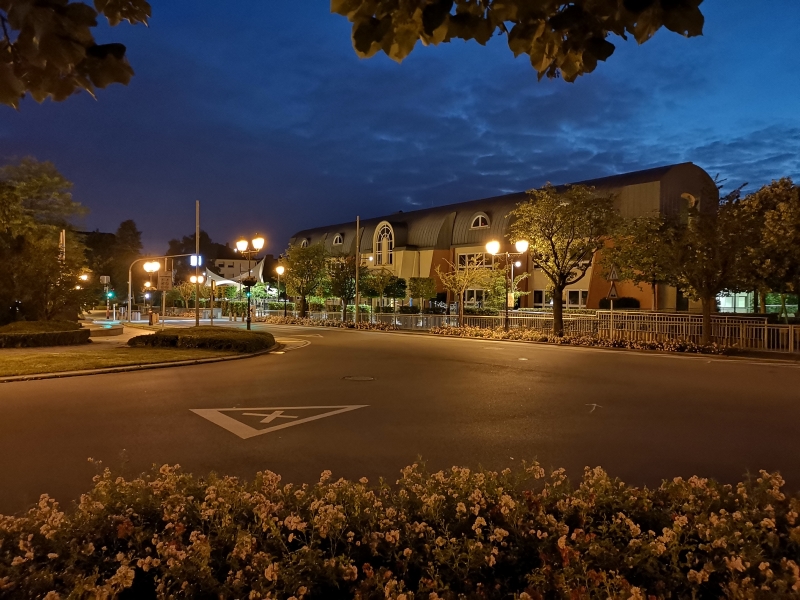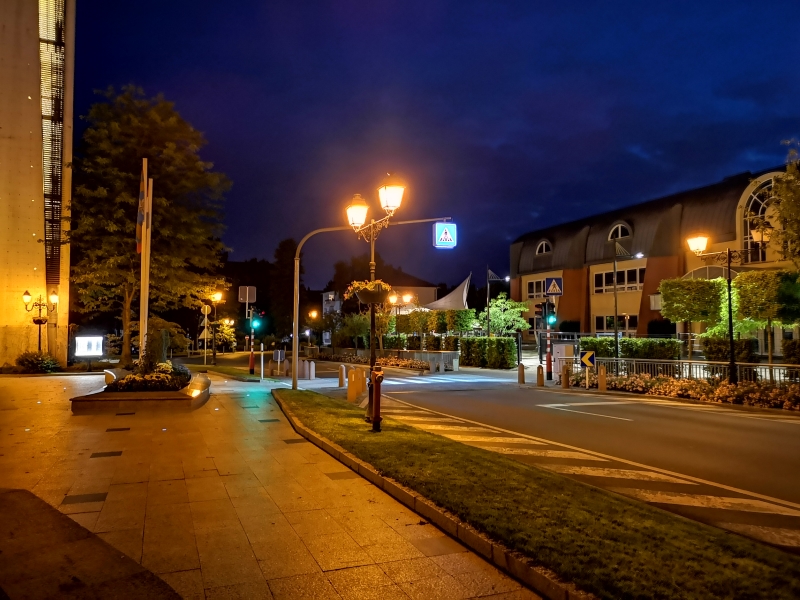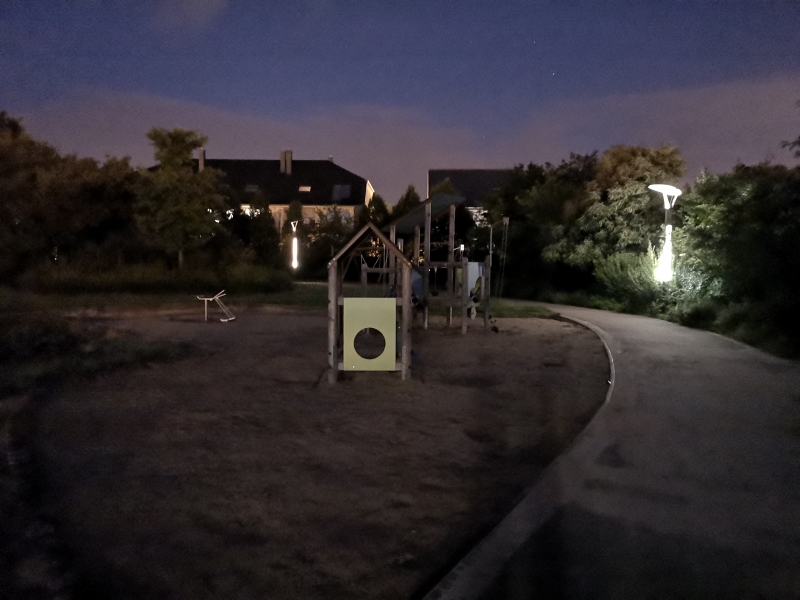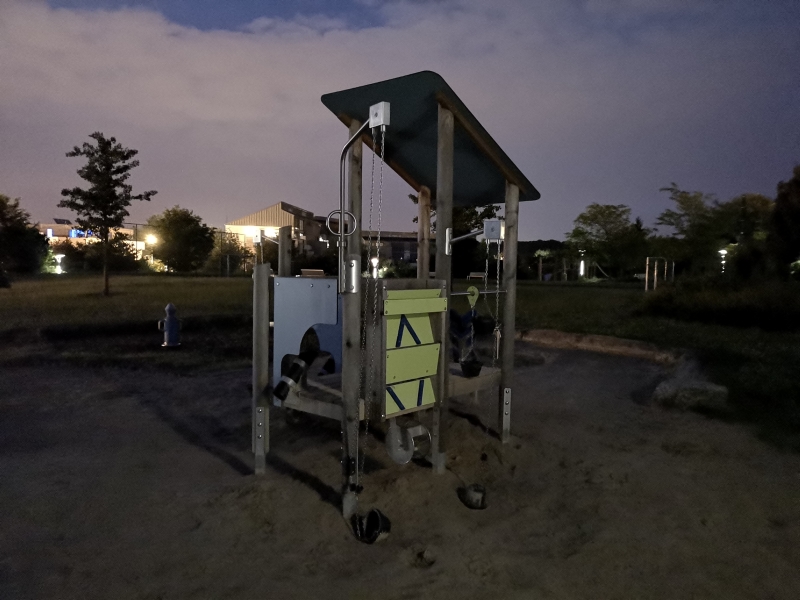The Huawei P20 & P20 Pro Review: Great Battery Life & Even Better Night Vision
by Andrei Frumusanu on June 15, 2018 11:00 AM ESTCamera - Low Light Evaluation
Low-light photography is one area the where the P20 Pro and P20 promised to bring great improvements. On the P20 Pro this is largely achieved through the ability of the sensor to do pixel binning and thus combine 2x2, meaning four, physical pixels into a single logical pixel. In theory this improves light sensitivity of the sensor by 4x and equivalent to a sensor with 2µm pixel pitches, which would make it by far the most sensitive sensor in smartphones.
Another feature to complement the improved low light capture and processing abilities of the P20s is a much improved “Night” mode. This was a feature which was present in Huawei cameras for some time now, essentially it is a multi-frame long-exposure capture mode that does computational combination of the shots into a single resulting high exposure shot. The difference with the P20 versus past implementations is the fact that the algorithm has now substantially improved shake compensation, meaning it’s now actually usable in handheld mode without a tripod and it will still come out sharp.
[ P20 Pro ] - [ P20 ] - [ P10 ]
[ Galaxy S9+ ] - [ iPhone X ] - [ Mi MIX 2S ] - [ Pixel 2 XL ]
Starting off with the first scene after sundown, we see that the P20 Pro’s 40MP shooting mode becomes very uncompetitive in low light due to its 1µm pixel pitch, and although both shots opt for the same exposure time and ISO, the 40MP clearly suffers from blurriness and lack of detail.
The P20 Pro’s 10MP shot is able to offer much better dynamic range and thus also better contrast than the Galaxy S9 or for that matter any of the other comparison devices. The P20 also does extremely well in terms of exposure, coming very similar to the P20 Pro, but having a noticeable disadvantage in terms of detail retention.
[ P20 Pro ] - [ P20 ] - [ P10 ] - [ Mate 10 Pro ]
[ Galaxy S9+ ] - [ iPhone X ] - [ Mi MIX 2S ] - [ Pixel 2 XL ]
In this shot the P20’s were the only phones to have sufficient dynamic range to now blow out too much of the blue street crossing sign as well as the left message board. The P20 again posts very similar exposure as the P20 Pro – but lagging behind in terms of overall detail. While the P20’s won in dynamic range, they lose out in terms of detail retention against the competition. Unfortunately all of my S9 shots ended up out of focus for some reason so that shot should only be used as a comparison in terms of exposure.
[ P20 Pro ] - [ P20 ] - [ P10 ] - [ Mate 10 Pro ]
[ Galaxy S9+ ] - [ iPhone X ] - [ Mi MIX 2S ] - [ Pixel 2 XL ]
In this scene, the P20 Pro outright flexes its muscles as it’s able to be the uncontested winner in terms of dynamic range, exposure, colour balance and detail retention by a large margin over all other phones. The P20 follows the P20 Pro in terms of exposure, but its detail retention is no better than competing smartphones.
Extreme low light photography
Generally for the P20 Pro, the less light there is, the better it will perform when compared to the competition. So stark is the difference in light capture capability, that generally there’s very little the other phones can do. I decided to have a little fun and throw the phones into what is essentially impossible scenarios where you wouldn’t expect a normal camera, yet alone a smartphone to perform.
[ P20 Pro ] - [ P20 ]
[ P10 ] - [ Mate 10 Pro ]
[ Galaxy S9+ ] - [ iPhone X ] - [ Mi MIX 2S ] - [ Pixel 2 XL ]
In this first scene there’s little to talk about existing phones as they mostly aren’t able to capture much at all besides some bushes around the light post. The P20 and P20 Pro on the other hand are able to resolve enough that we can actually make out what’s in the scene. The night mode on both phones demonstrate just what is possible in terms computational photography and the results are impressive.
On the P20 Pro in particular is particularly able to resolve a stupid amount of detail while this effectively was a 6 second handheld exposure.
But the real impressive shot is actually the regular 10MP mode – the camera here kicked in into high ISO mode and the resulting shot is a 1/4th second exposure at ISO51200, essentially a first in a smartphone.
[ P20 Pro ] - [ P20 ]
[ P10 ] - [ Mate 10 Pro ]
[ Galaxy S9+ ] - [ iPhone X ]
The second extreme low light scene has just a little more light as it’s being faintly illuminated by the dim walkway light. Again the P20 Pro’s 10MP mode shot results in a 1/4th second exposure at ISO51200 and the result is just astounding, and pardon the pun, simply night and day when compared to other phones. Even though the P20 doesn’t have any special light capture hardware, in Night mode it still manages to vastly outperform the competition. Funnily enough, the Mate 10 performs really well in terms of exposure in its Night mode here, but as it lacks the shake compensation feature of the P20’s, the resulting image is quite a blurry mess, and why that mode was generally unusable in the past unless you put the phone on a tripod or fixture.
Generally the P20 and P20 Pro impressed in low-light capture. The P20 doesn’t have any special hardware so most of its quality improvement are solely due to software processing improvements. Night mode in particular as a concept isn’t anything that’s bound to any hardware configuration so it’s fantastic to see Huawei push innovation and evolving it into something really special.
In terms of actual light capture, the P20 Pro’s massive sensor is just without competition. Both the hardware and the software processing make this easily the most competitive smartphone in low-light scenarios. At high ISO settings, we’re seeing astounding and never-before-seen results from a smartphone that really pushes the envelope of what can be done in a mobile device.













































81 Comments
View All Comments
Belldandy - Saturday, June 16, 2018 - link
Just an interesting note: I have the Canadian version of the P20 Pro, single sim card.running version: CLT-L04 8.1.0.109(c792)
I got scores of Sling Shot Extreme Unlimited graphics: 3114 Physics: 2821
But T-Rex was 123fps
Manhattan 3.1 Off-screen was 39 fps
So maybe it has been fixed on my phone like the Mate 10 pro
arayoflight - Friday, June 15, 2018 - link
Are you planning to review the OnePlus 6 as well?greenbat - Friday, June 15, 2018 - link
Great article. I was wondering about the AI benchmark. It would be intersting to see whether the android 8.1 on the p20 give better results compared to the android 8.0 Mate 10. Any change to test that?And the next firmware upgrade of the mate 10 gives night shot without tripod, just like p20
amouses - Friday, June 15, 2018 - link
The Huawei P20 Pro is an awesome phone, especially for people whose usage includes predominantly photography. But as a Huawei fanboy or maybe ex fanboy beware. Huawei have a habit of providing poor Software upgrades (security) and OS upgrades for phones. And so my official requests to them about Android P support for a phone ironically named P20 have gone unanswered to date. So Huawei, do you commit to upgrading your flagship phone, say by Dec 31st 2018? or will users as per your previous flagship products be saddled with excellent hardware and totally out of date Android Software. Your call.Trixanity - Friday, June 15, 2018 - link
Second paragraph in the conclusion "Huawei tried to take some design queues from Apple’s iPhone X" should be design cues I'd wager :)Are there any plans to revisit the GPU benchmarks later? Huawei's alleged black magic (which they call GPU Turbo that supposedly has significant improvements to performance and power efficiency) seemingly coming out of thin air will be released to a wide range of models including the P20 in July. Would really like to see not only benchmarks but a dissection of what it is and how it works if possible.
South_DL - Friday, June 15, 2018 - link
These continental Chinese phones are nothing but a mix of plagiarism from both Apple and Samsung, how in earth such a thing can be legal in the US?Retycint - Friday, June 15, 2018 - link
Because you can't trademark things like a notch or a glass back, that's why. And these phones are much more than just "iPhone/Samsung clones", unless you're telling me you didn't even read the review and skipped straight to the comments section to complain?prisonerX - Friday, June 15, 2018 - link
You can't copyright, patent or restrict an idea, only a specific instance, expression or design.Your notion of "plagiarism" is how people have been designing things forever, and it benefits consumers. Why someone would be worried about where ideas come from rather than whether they're good or bad, I'll never know.
levizx - Saturday, June 16, 2018 - link
You are plagiarizing, because 1+1=2, and you can't use it EVER.sonny73n - Sunday, June 17, 2018 - link
@south_dlYou’re such a shallow minded. Go on gsmarena and check the last 4 iPhone generations (6,6s,7 and 8) and Meizu see who stole design from whom. And the bezel-less design of iPhone X is also a steal from another Chinese phone.
By the way, your beloved Apple trademarked “slide to unlock” and “tap center of status bar to scroll up back to top”. LOL